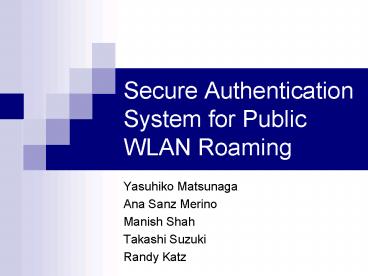Secure Authentication System for Public WLAN Roaming - PowerPoint PPT Presentation
1 / 23
Title:
Secure Authentication System for Public WLAN Roaming
Description:
Rogue AP - DoS. Lack of cryptographic bindings causes several security vulnerabilities ... L2 DoS attack is still possible. L2 Auth. Web Auth MD5(K1) ... – PowerPoint PPT presentation
Number of Views:68
Avg rating:3.0/5.0
Title: Secure Authentication System for Public WLAN Roaming
1
Secure Authentication System for Public WLAN
Roaming
- Yasuhiko Matsunaga
- Ana Sanz Merino
- Manish Shah
- Takashi Suzuki
- Randy Katz
2
Agenda
- Single sign-on to confederated wireless networks
with authentication adaptation - Privacy information protection using policy
engine - Improve security of web-based WLAN authentication
by binding 802.1x link level authentication - Performance Measurement
3
Loose Trust Relationship in Current Public
Wireless LAN Roaming
(ISPs, Card Companies)
ID Provider
Strong Trust
WLAN Service Provider
WLAN Service Provider
Strong Trust
No Trust
Weak Trust
User
- Each WLAN system is isolated, deploys different
authentication schemes - Users have to maintain different ID and
credentials
4
Challenges and Our Solutions
- Confederate service providers under different
trust levels and with different authentication
schemes to offer wider coverage - Alleviate user burden of maintaining different
identities and credentials per WLAN provider - SSO Roaming with Authentication Adaptation
- Select proper authentication method and protect
privacy of user information per WLAN provider - Policy Engine Client
- Avoid theft of wireless service without assuming
pre-shared secret between user and network - L2/Web Compound Authentication
5
The Single Sign-on concept
Single sign-on
ID Provider
Office (provider C)
Street (provider B)
Initial Sign-on
Coffee shop (provider A)
Confederation
- Single username and password
- Users authenticate only the first time
- Inter-system handover with minimal user
intervention - Each network may deploy its own authentication
scheme
6
Single Sign-on Technology
- Currently two technologies clearly accepted by
industry - RADIUS Proxy-based authentication scheme
- Liberty Alliance Redirect-based authentication
scheme - We adopted both of them for our implementation
- Need authentication adaptation framework
7
Authentication Adaptation Flow
(1) Request authentication
User Terminal
WLAN Service Provider
(2) Announce - provider id - authentication
methods - charging options - required user
information
(3)Select authentication method according to
users preferences
(4) Submit - selected authn. method - selected
charging option - user information
(5) Authenticate the user
8
Client-side Policy Engine
- Control automatic submission of user
authentication information according to
communication context - Context includes trust level of provider, cost,
etc. - Authentication/Authorization flow adaptation
- Switch between Proxy-based (Radius) and
Redirect-based (Liberty-style) single sign on
9
Policy Engine Architecture
End User
WLAN provider
Client
Policy Enforcement Point
Policy Check Engine
Auth Info. Repository
Capability
AAA Server
Web Browser
Applet
Policy
Policy Repository
Context
EAP/ 802.1X
10
Security Threats of Web-based Authentication and
Access Control
- Lack of cryptographic bindings causes several
security vulnerabilities
Rogue AP -gtDoS
Web Server
No Data Encryption -gtEavesdropping
Gate-control (IP/MAC)
No Message Integrity Check -gtMessage Alteration
External Network
IP/MAC spoofing-gt Theft of Service
11
L2/Web Compound Authentication
RADIUS/Web Server
(1) 802.1x TLS guest authentication
(2) Establish L2 Session Key
Client
Access Point
(4)Firewall Control
(3) Web Auth (with L2 session key digest)
External Network
- Prevent theft of service, eavesdropping, message
alteration - Dont work for L2 DoS attack out of scope
12
WLAN Single Sign on Testbed
Identity Provider
External Network
Web Server
Radius
RADIUS
SOAP
HTTPS
Service Provider 1
Service Provider 2
Radius
Fire wall
Radius
Radius
Fire wall
RADIUS
Web
Web Portal
Web
HTTPS
802.1x
Client
Client
MC
MC
13
Authentication Adaptation User Interface
14
Layer 2 Roaming User Interface
15
Delay Profile Evaluation
(Units sec)
16
Conclusions
- Secure public WLAN roaming made possible by
accommodating multiple authentication scheme and
ID providers with an adaptation framework - Policy Engine reflects user authentication scheme
preference and protects privacy of user
information - Compound L2/Web authentication ensures
cryptographically-protected access - Confirmed with prototype, measured performance
shows reasonable delay for practical use - Exploits industry-standard authentication
architectures Radius, Liberty alliance
17
backup
18
Public Wireless LAN Service Model
- The network is open to users without pre-shared
secret
AAA Servers
User Category
Services
(1)Monthly/Pre-paid Subscribers
Premium Contents External Network Access
(Subscriber Pays)
(2)One-time Users
WLAN Infra-structure
Free Advertisement Contents (Hotspot
Owner Pays)
(3)Non-Subscribers
19
802.1x/11i/WPA L2 Network Authentication and
Access Control
- Conventional Closed-style authentication Only
hosts with pre-shared key can access the network,
Mainly for Corporate WLAN
(1) Mutual TLS authentication with pre-shared key
(2) Establish L2 session key dynamically
(3) Only successfully- decrypted packets are
forwarded
External Network
20
L2/Web Authentication Comparison
21
Our Approach
- Compound L2/Web authentication to ensure users to
have cryptographically-protected wireless LAN
access - Use 802.1x guest authentication mode, embed L2
session key digest in web authentication - At layer 2, do not assume pre-shared secret
- Digest embedding is necessary for avoiding race
attack - After Web authentication, user gets full access
- Otherwise, users have limited access to free
contents - L2 DoS protection is out of scope
22
Race Attack Scenario
(Why L2 session key digest embedding is necessary)
Legitimate Client
Malicious Client (MAC Spoofer)
AP
RADIUS/Web
Firewall
L2 Auth
Bind (MAC, MD5(K1)
L2 Auth
K1
K1
L2 Auth
Web Auth MD5(K1)
Bind (MAC, MD5(K2))
L2 Auth
(L2 Session key verify NG)
K2
K2
- Theft of service can be prevented by
authentication binding - L2 DoS attack is still possible
23
Compound Authentication Testbed
RADIUS/Web Server
(1) 802.1x TLS guest authentication
(2) Establish L2 Session Key
Client
Access Point
FreeRADIUS 0.8.1 Apache 2.0.40
Cisco AIR-350
(4)Firewall Control
(3) Web Auth (with L2 session key digest)
Xsupplicant 0.6 libwww-perl 5.6.9
External Network
(rejected)
Attacker

